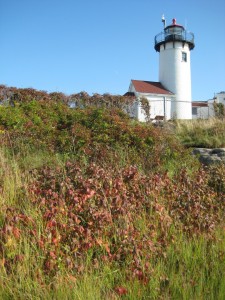It’s summer, it’s warm and sunny and the leaves are all green and blowing in the warm breeze, and school is out and life is good and whoa! What’s that? A red leaf.
It’s like seeing a “Back-to-School Sale!” sign in the mall. A sudden warning that the summer has once more fled away and fall is imminent. But it’s not a whole tree going gold or scarlet; that happens later, in fall, right? It’s not October yet. This is just a warning shot—a single leaf here, a branch there. A vine suddenly goes red as a traffic light, bringing you up short.
Why, though? Why do some plants abruptly turn bright colors, so that they stand out from the green background? Not to warn us that we should sunbathe while we may. The reason that some plants turn color early has nothing to do with human needs or wants.
Birds, especially berry-eating birds, generally have good color vision. They notice and are attracted to bright hues, especially red. Plants that have berries need to protect their seeds until they’re fully matured and ready to create the next generation, so unripe fruits tend to be greenish, hidden under shady leaves. But once the berries are ripe, the plant “wants” birds to come and eat them, so that the seeds can disperse.
Poison ivy is one of these plants that turn colors early. Its seeds are hard-shelled and heavy, and don’t have parachutes or wings like so many other wild seeds, but they can fly far and wide when encased in a coat of feathers. Other plants using this colorful strategy are Asian bittersweet which turns bright gold, many species of dogwood shrubs which go a deep maroon, and the scarlet leaves of Virginia creeper, usually the first plant to point out that it’s time to get the chimney cleaned and buy wool socks and write the book report and…






Recent Comments